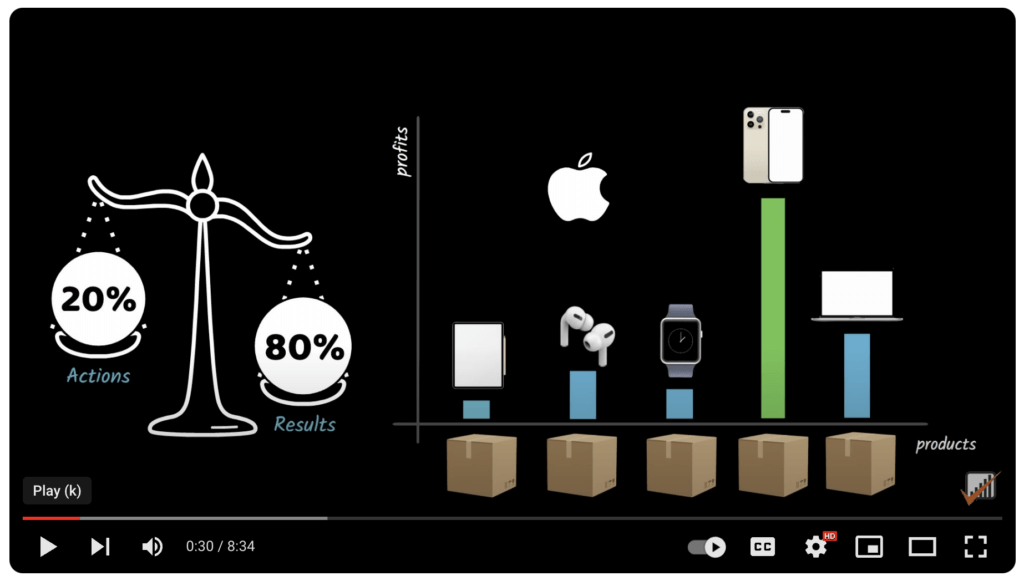Most business owners struggle because they’re winging it.
Many have no operating system, don’t focus on growth, and as a result, their wins are more ad-hoc.
Sometimes, it works out well, but most of the time it just results in wasted time, effort, and resources.
Understanding the 80/20 Rule to scale your business results in more focused activity and results based activities.
Today, we’re specifically diving into how to use the 80/20 Rule to scale your business.
What is the 80/20 Rule?
Pareto observed that 80% of the land in Italy was owned by only 20% of the population. He also witnessed that 20% of the plants in his garden were bearing 80% of the fruit.
What the 80/20 rule looks like in business?
Most entrepreneurs start their business by working ON their business. They figure out their ideal potential customer and how to service that customer in the best way possible.
But slowly, as the business grows, time gets lost in activities that don’t promote business growth, training new team members, inefficient workflows, administration and meetings (And not the typical productive kind of meetings).
Here’s how the 80/20 rule translates in business;
- 20% of processes produce 80% of the results
- 80% of conversions may come from 20% of the marketing campaigns.
- 20% of your profits come from 80% of your clients
- 80% of revenue may come from 20% of the products or services offered for example, in the case of Apple, where the iPhone accounts for 80% of sales.

What are the benefits of adopting the 80/20 Rule?
The 80/20 rule, or the Pareto Principle, offers a straightforward approach to scaling and boosting your metrics efficiently by prioritizing initiatives effectively.
By implementing this principle, you not only expedite growth but also unlock additional benefits such as:
- Clear Priorities: It provides clear priorities for you and your team, enabling focused efforts on tasks with the most significant impact.
- Increased Daily Productivity: By concentrating on the vital few tasks that drive the majority of results, you can enhance daily productivity and achieve more in less time.
- Segmented Workload: The principle allows you to segment your work into manageable portions, making it easier to tackle complex projects or goals.
- Focused Activity: Utilizing the 80/20 rule promotes a more focused strategy, ensuring that resources are allocated to areas with the highest potential for success, thereby maximizing outcomes.
The 80/20 Principle: The Secret to Achieving More with Less
In 1999, Richard Koch published The 80/20 Principle: The Secret to Achieving More with Less
Koch is an entrepreneur who made over $300 million from starting businesses and investing in early-stage venture capital.
In his book, Koch reveals how entrepreneurs can use the 80/20 rule in a systematic and scale their businesses and improve their lives.
The book in it’s essence is similar to the eMyth Revisited but focuses on practical applications.

The 80/20 Rule for EOS®
In EOS® perfect is the enemy of done. Consider these two scenarios;
Scenario 1:
You dedicate the next few months (or quarters, even a year) to thorough research into the best practices prevalent within your industry. This involves scrutinizing various approaches adopted by others and meticulously selecting the most fitting ones to integrate into your own framework.
Following this, you’ll embark on the meticulous task of documenting these practices in comprehensive detail, subjecting them to rigorous proofreading, and conducting trials to gauge their effectiveness.
Analyzing the trial outcomes will then inform potential adjustments, prompting iterations of the process as needed. Only after thorough testing and refinement will the finalized practices be ready for full-scale implementation.
❌ Outcome:
Wasted effort and time with 0 surety of results
Scenario 2:
Alternatively, you can opt for a streamlined approach to establishing best practices, adhering to the principles of the 80/20 rule. By distilling the essential components of your processes into a succinct set of major steps, accompanied by brief bullet points under each, you can create a framework that is easily understandable and implementable.
- Document your processes
- Get your processes followed-by-all
- As circumstances evolve, any necessary modifications can be swiftly incorporated, ensuring continued relevance and efficacy.
✅ Outcome:
Ability to see results from the get-go with the ability to focus time and effort on results-producing activities.
5 ways to Apply the 80/20 Rule to scale your business
1. Identify the most profitable products or services 🏋️♂️
By analyzing sales data, your business can determine which products or services contribute the most to your overall revenue and focus on promoting and improving those.
Then, focus your activities on improving those.
It doesn’t mean you don’t make room for testing new products and services, just like we did with Alice, but it means you drop what doesn’t work.
2. Prioritize the right tasks and projects
“You are hugely more productive at some things than others but dilute the effectiveness of this by doing too many things when your comparative skill is nowhere near as great.” (Medium)
The same is true for your team members.
By focusing on the right tasks and projects that will impact your business, you can allot and assign your resources more efficiently and effectively.
To get the best from you and your teams, keep your eyes focused on the metrics and goals you want to achieve.
3. Document core processes
By identifying the steps in your systems and processes that take up the most time or resources, your business can streamline and optimize those steps to improve efficiency and reduce costs.
Documenting your core processes means documenting 2o% of the processes that create 80% of the results.
4. Analyze and improve processes
The 80-20 principle is a culture, not a one-time exercise. It’s a mindset of continuous improvement.
For example, consider your marketing process. By applying for instance, the 80/20 rule in marketing, you can analyze which marketing channels or tactics are most effective at generating leads or sales. Your business can allocate more of its marketing budget to those efforts.
It’s all about continued process improvement.
5. Say NO to distractions
What activities do you spend time on in your business that yield little to no impact? Can you delete them altogether or at least minimise them?
We love these “7 hacks that save me 20 hours a week” from Amada Goetz, which include
- No email before 10am
- Use templates
The more you say no to distractions, the more you’ll be able to focus on tasks that shift the needle.
Bottom line?

In conclusion, implementing the 80/20 rule, also known as the Pareto Principle, can revolutionize the way businesses operate and scale. By focusing efforts on the vital few aspects that yield the greatest results, rather than spreading resources thinly across everything, companies can achieve remarkable efficiency and growth.
Embracing this principle encourages prioritization, optimization, and a relentless pursuit of the most impactful strategies. Whether it’s systemizing operations, refining product offerings, or targeting high-value customers, harnessing the power of the 80/20 rule enables businesses to work smarter, not harder, ultimately propelling them toward sustainable success in an increasingly competitive landscape.

Readiness to Scale Assessment
Almost everyone wants to scale their business but where to start? Take our Readiness to Scale Assessment to find out! You’ll be presented with 10 statements that correlate to one of three specific scaling stages in business.








